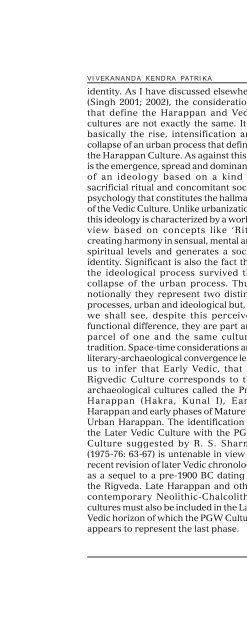Aryan Invasion Theory - Publication - Vivekananda Kendra
Aryan Invasion Theory - Publication - Vivekananda Kendra
Aryan Invasion Theory - Publication - Vivekananda Kendra
Create successful ePaper yourself
Turn your PDF publications into a flip-book with our unique Google optimized e-Paper software.
VIVEKANANDA KENDRA PATRIKA<br />
identity. As I have discussed elsewhere<br />
(Singh 2001; 2002), the considerations<br />
that define the Harappan and Vedic<br />
cultures are not exactly the same. It is<br />
basically the rise, intensification and<br />
collapse of an urban process that defines<br />
the Harappan Culture. As against this, it<br />
is the emergence, spread and dominance<br />
of an ideology based on a kind of<br />
sacrificial ritual and concomitant social<br />
psychology that constitutes the hallmark<br />
of the Vedic Culture. Unlike urbanization,<br />
this ideology is characterized by a worldview<br />
based on concepts like ‘Rita’<br />
creating harmony in sensual, mental and<br />
spiritual levels and generates a social<br />
identity. Significant is also the fact that<br />
the ideological process survived the<br />
collapse of the urban process. Thus,<br />
notionally they represent two distinct<br />
processes, urban and ideological but, as<br />
we shall see, despite this perceived<br />
functional difference, they are part and<br />
parcel of one and the same cultural<br />
tradition. Space-time considerations and<br />
literary-archaeological convergence lead<br />
us to infer that Early Vedic, that is,<br />
Rigvedic Culture corresponds to the<br />
archaeological cultures called the Pre-<br />
Harappan (Hakra, Kunal I), Early<br />
Harappan and early phases of Mature or<br />
Urban Harappan. The identification of<br />
the Later Vedic Culture with the PGW<br />
Culture suggested by R. S. Sharma<br />
(1975-76: 63-67) is untenable in view of<br />
recent revision of later Vedic chronology<br />
as a sequel to a pre-1900 BC dating of<br />
the Rigveda. Late Harappan and other<br />
contemporary Neolithic-Chalcolithic<br />
cultures must also be included in the Late<br />
Vedic horizon of which the PGW Culture<br />
appears to represent the last phase.<br />
19<br />
ARYAN INVASION THEORY<br />
The debate on Vedic-Harappan identity<br />
relates mostly to the correspondence<br />
between Rigvedic and Early-to-Mature<br />
Harappan cultures. This identity is<br />
based on three basic parities between<br />
the two: geographical, chronological<br />
and cultural. Let us discuss them<br />
briefly.<br />
Rigvedic and Early-to-Mature Harappan<br />
geographical horizons coincide The core<br />
area as well as the contact area of the<br />
Rigvedic and Early-to-Mature Harappan<br />
cultures are found to be one and the<br />
same. The region extending from the<br />
Sarasvati Valley in the east to the left bank<br />
of the Indus in the west was the cradle of<br />
both the cultures. It is known as Sapta<br />
Sindhavh in the Rigveda (8.24.27) and it<br />
is the region in which the maximum<br />
number of Harappan sites is located. Still<br />
more important is the fact that within this<br />
core area too it is the Sarasvati region<br />
that constitutes the pith. The Vedic<br />
Culture originated on the banks of the<br />
Sarasvati and, as I had shown earlier<br />
(Singh 1997-98b) and has now been<br />
confirmed also by Shrikant G. Talageri<br />
(2000: 103-5), during the time of<br />
composition of the earliest hymns, the<br />
Vedic people were not acquainted with<br />
the river Indus. Of course, later in the<br />
Rigvedic period itself they reached the<br />
Indus , settled in its valley and glorified<br />
it, but Sarasvati continued to be the most<br />
important river for them (Rigveda<br />
2.42.16). Recent archaeological<br />
discoveries prove that the Harappan<br />
Culture too is basically a Sarasvata<br />
Culture. The Harappan sites in the<br />
Sarasvati Valley far outnumber those<br />
located in the Indus Valley . The latest<br />
counting as given by B. B. Lal (2002: 47-

















